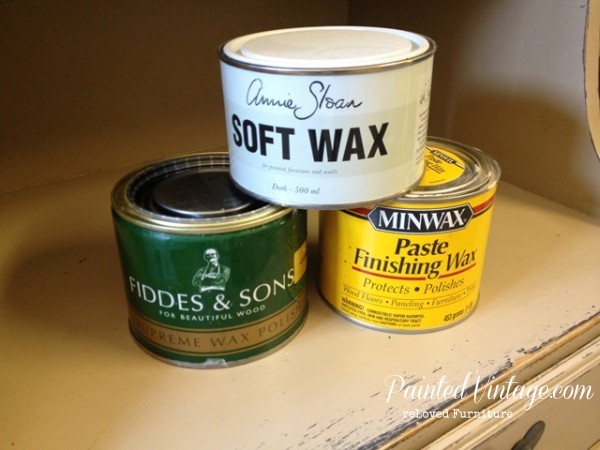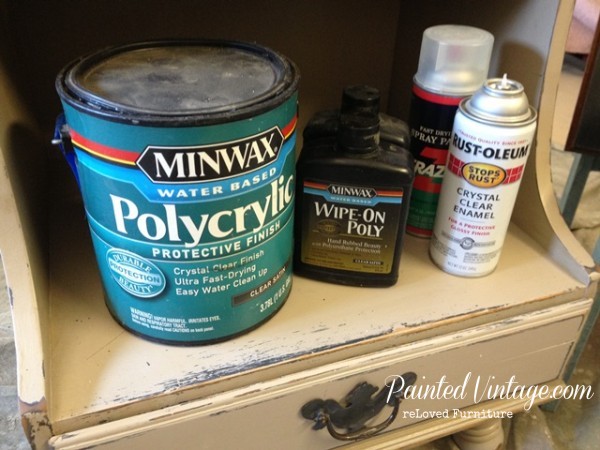To wax or not to wax?
Ah… The age old question: “To wax or not to wax over chalk paint?”
OK, so maybe it isn’t the question that’s been around for as long as chalk paint itself, but it is definitely a dilemma I’ve been facing more and more…
Nothing compares to the soft luster and rich glow of a freshly waxed piece of reLoved furniture!! However, applying wax over chalk paint is the most challenging, labor intensive and time consuming aspect of painting furniture with chalk and chalk-style paint.
Granted, not all waxes are created equal. Some waxes are downright difficult to work with and even require you to take a special class on proper application techniques.
Then there’s the durability issue.
Yes, I have an issue… Wax only offers minimal protection and wax is NOT permanent. Nor is it even semi-permanent. In fact, if it was a hair dye, it would be temporary!!
You see, wax wears off over time with use, leaving your beautiful chalk painted furniture all porous and exposed; a magnet for chocolaty little fingers and cheese puff smudges!
In order to maintain continued protection, wax needs to be reapplied every few months!
But wax isn’t THE ONLY option!
Why not go with a water-based polyurethane sealer, such as Varethane or Polycrylic over chalk paint?
These products are an excellent alternative, and offer far superior protection than a wax. A few coats of polycrylic will last YEARS beyond a few coats of wax, and can be much easier to work with.
Plus, polycrylics are more chemical resistant and are not heat sensitive like wax.
And unlike wax, if you ever chose to repaint your furniture, the polycrylic does not need to be 100% completely removed.
Don’t get me wrong, polycrylics are not without drawbacks.
Although they can have a yellowing effect over white and light colors, I personally have had good success with Varethane staying clear. Some waxes will yellow also, so that can still be an issue if you went that route. (I have also used clear spray-on sealers for smaller projects, with no issues what-so-ever!)
With the ease of application, I am finding water-based polyurethanes to be my go-to finish of choice over chalk painted furniture.
And if you are looking for a good alternative to do-it-yourself chalk-style paint, read my post on an Not So DIY Chalk Paint Recipe.
I’d love to hear your feedback! What is your sealer of choice over chalk paint and chalk-style paint on your reLoved furniture, and what, if any, challenges do you face?
**UPDATE**
Still have questions?? I posted an update with answers to all the most commonly asked questions I’ve received.
You can read it here: “Wax or Polycrylic Over Chalk Paint?”








I’m new to chalk painting and I’m already over the wax finish as it’s too time consuming to apply (not using brand name chalk paint or wax). I’m going to look into water based poly clear coat as I think that will be much easier to apply.
Hi! I have been wondering about this for a while now!!! I have furniture that is sealed with wax so can I paint a finish over the wax??
Hi Staci- unfortunately, you cannot apply anything over wax. The wax would need to be completely removed (you can do this with mineral spirits/paint thinner and rags) before you apply any other type of finish.
You can, however, use chalk paint over wax.
I’ve painted hundreds of pieces of furniture over the years. Typically I use wax for pieces that won’t get tons of use, like a bedroom side table, or small surface. If it’s a kitchen table, dresser top, etc. I usually use water based poly. However, there is a product that is a sealer/clear topcoat that can be used over wax. Artisan Enhancements by Aloha Coatings has “Clear Topcoat” which is non-yellowing, and can be used over or under wax, can be buffed to a higher sheen and more. Check it out.
Wow!! Ann!! I have never heard of a product that can be applied over wax… Thank you so much for the info! I am going to check it out!
Can the other types of seals and finishes go directly over the chalk paint, or do they need to be waxed, then sealed?
Hi Vicky, yes, you can use other sealers directly over chalk paint… But if you wax, you cannot put anything over the wax. You can do the reverse however and apply a sealer and then wax over that. Just remember, if you wax, it MUST be the last step!
Hi, I’m new to using chalk paint. There’s so much information out there I think I’m getting overwhelmed! Eventually I want to do my kitchen cabinets but I’m leary about only having the dark wax as the final finish. I want to be able to wipe the cabinets with a damp rag when needed and not have to reapply wax periodically. If I use Annie Sloan chalk paint & dark wax can I still wipe on or spray on some kind of sealer? Which sealer is the easiest to use and doesn’t require a mask? Thanks!
Hi Annemarie- you cannot apply anything over the wax. The wax has to be the final finish. You could achieve a similar effect by using a glaze over the chalk paint and then a poly over the glaze.
I’ve been doing this for over 20 years. Poly over the paint….then glaze (paint can absorb too much glaze) and you won’t be able to fix it with wiping. If you love the finish after glaze, then put another coat of water based poly on top. Water based polys don’t typically yellow over time like oil based,,,,, but if you do not let the paint dry completely for 3 days it can yellow white or other light coloured paints.
Please help if you can…I am getting ready to pull the laminate off of my cupboards and paint them. The chalk paint seems great for ease of use and some are not toxic and since I am going to paint the insides as well…that is a huge plus. But part of the reason for going through all of this is because the white laminate is cold looking and I wanted to use a warmer white and then some aging around the bevels. Can I use chalk paint, a tinted glaze that I wipe most of it off and just leave in the creases and then a poly? I only heard about chalk paint yesterday and I was sold…until I learned about the waxing. I have little experience in painting but this kitchen is making me sick! Lol thanks in advance for your help.
Hi Shiloh,
I am not a huge fan of Chalk Painted cabinets, but I know many who have done this with great success and are thrilled with the outcome.
Yes, you can. The procedure you outlined will definitely work! However, I’d suggest a couple (or several) coats of the poly after. Also, I’d recommend painting a couple scraps of wood with the chalk paint to use as testers for your glaze. Make sure you have the color and technique of the glazing down before you apply to your freshly painted cabinets.
Good luck on your project! It’s going to be a lot of work, but so worth it in the end! I’d love to hear how it turns out
Sherri,
Thanks for all the information you’ve posted on waxes vs. poly. I’ve used both and like the look of each. Question: can you poly over a waxed finish?
Thanks,
Hi Kristi- To answer your question, you cannot apply a poly over a wax. If you are going to be using a wax, that needs to be the final coat.
But you can go the other way and wax over a poly.
I just did my first piece in CeCe’s Caldwell vintage white chalk paint…Loved how it went on…Next day distressed it and started to use CeCe’s clear wax in a little spot..turned brown…so I switched to Polycrylic clear satin finish and it turned into a tinted yellow once it dried…..but it looks antique…hoping it doesn’t keep getting more yellow as it sets….or I will be doing it all over again in a latex paint!
I’d like to know if you’ve applied the wax and don’t like the end results and want to repaint the whole piece. What do you do to get wax off?
Hi Nancy, you can remove the wax with Mineral Spirits (Paint Thinner) and rags. Just make sure you get all of it off before repainting or applying another finish.
Oh, so I have a side table that I just did. I waxed it but real should have poly’d it. You’re saying if I wipe it down with mineral spirits then I put the poly or Varathene over it? That’s wonderful if I can!!!
Yes, the mineral spirits will remove the wax.
Wax v. Poly the age old question. I LOVE the look and feel of wax. I use American Paint Company Clear Top Coat. I brush it or wipe it on. It dries in 20 minutes, then I buff it gently using 1000 grit paper or even brown paper bag from the grocery store. It leaves a beautiful durable finish. Oh, and the poly and waxes you pictured here are down right lethal. I’m chemical and odor sensitive. The APC products are all natural.
I ordered some of APC’s Clear Top Coat and I can’t wait to try it out. I have also heard good feedback on their Vintage Antiquing Wax / Dark Wax…
Luckily, I’m not sensitive to odor or chemicals, but this is good information for those who are! Thanks
I love the look of wax however, have had some experiences that have caused me to shy away from them. Luckily it was on my own pieces and not those of a customers.
I too have even steered away from the minwax poly too. Just discovered General Finishes High Performance water based poly. Cures out to a very hard finish. If I had the space my top choice would be an oil poly. or even a lacquer. But because I paint in my house this is the best top coat that provides a durable finish thus far.
Thank you for posting
Hi Donna, I recently read about a new acrylic-lacquer that is supposed to be a awesome product. I can’t remember who the manufacturer was… I’ll have to look in to that.
Was it called Acrylacq?
I have been rethinking chalk paint lately myself. I’m still a beginner, so I don’t have a lot of experience. By the time I put several on coats of chalk paint, then wax and wax, I probably could have primed, painted & sealed the furniture. I have wondered how the wax would hold up on a piece of furniture that gets a lot of use. I am thinking my next project will be a latex with primer in it.
Hi Dawn, I agree. It is a lot of work. I often lean towards my old school ways and go straight to priming and painting with high quality latex finishes!
I tend to use water based poly poly a lot over chalk paint because I’m kind of lazy when it comes to waxing. It is a lot of work putting two to three coats of wax hard on the arms! I have had some problems with it yellowing over light colors…
I have never tried varethane do you like it a lot? Traci
Yes, I love it, Traci! I have used that product for years (even back when it was Flecto Varathane Diamond Wood Finish) and in my opinion, it’s one of the best.
Thank you for speaking the truth! I have tried to tell this to people for a while now. Not to mention if your piece sits where it can be warmed by the sun, you get a mess! I love the look of a waxed piece, but I glaze and seal pieces that get a lot of wear and tear!
Hi Karen, yes!! The re-softening of the wax is a major concern for me as well!! I totally agree
Karen, Would you mind sharing with me how you do your glaze and seal? Thank you!
My wife and I just purchased that Minwax water based poly you have pictured there, hoping it won’t yellow our newly painted old-white chairs! This article comforts our thoughts of trying poly, a more permanent finish solution…so thank you! I DO have a question. Do you know if we can spray (HVLP gun connected to an air compressor) on that minxwax water based poly??
Hi Jeremiah! Yes, you can most definitely use an HVLP to spray the Polycrylic. I have a Graco HVLP and just finished spraying a set of cabinets with the Polycrylic in Satin. The finish came out very smooth, and looks gorgeous!